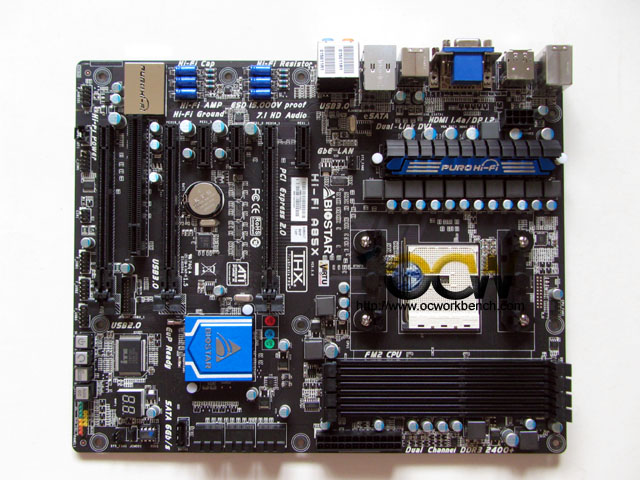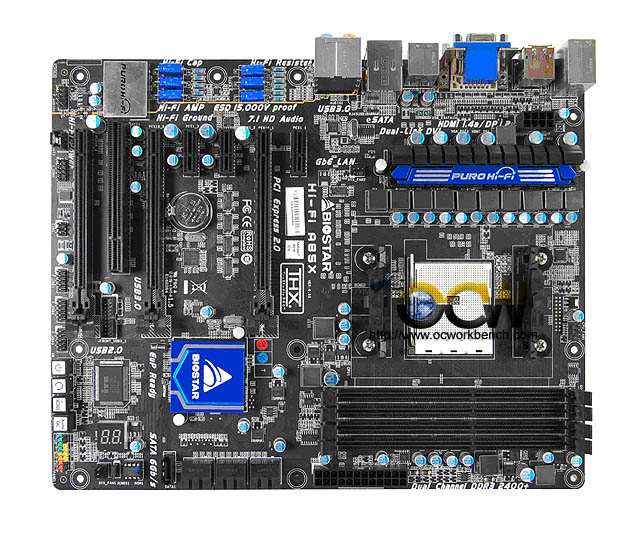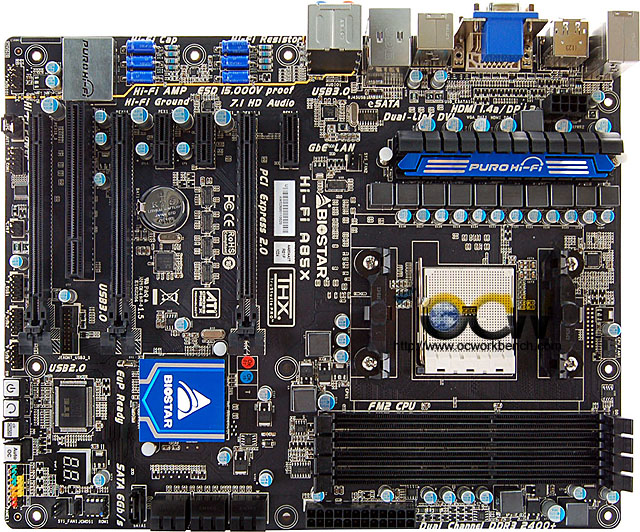Review of BIOSTAR Hi-Fi A85X socket FM2 motherboard
28 Sept 2012
In a few days time, AMD will introduce their next generation of graphics integrated processor or APU. The new APU uses a different socket type FM2 from the previous generation Socket FM1. The new series of processors, also has an improved performance especially in the area of multimedia encoding compared to the earlier generation.

In conjunction with the new generation of AMD processors, BIOSTAR releases a A85 chipset motherboard. This motherboard belongs to the HiFi Series and is known as BIOSTAR HiFi A85X.
The mothboard HiFi A85X supports the newest FM2 socket processors A4, A6, A8 and A10 + Athlon II X4 processors with a maximum TDP of 100W. It has 4 DIMM slots which operates in Dual channel mode and supports up to 64GB of memory.
The board also caters for those who wants maximum graphics performance. It has 3 PCIe 2.0 x16 slots that can work in X16+x8+x4 in CrossFireX mode. There is also 3 PCIe 2.0 and 1 PCI slot.
Native support of SATA3 or SATA 6Gbps supporting 7 SATA 6Gbps + 1 eSATA in RAID 0,1,5,10 modes. There is also native support for USB 3.0. There are two USB 3.0 ports, 1 USB 3.0 header, 4 USB 2.0 ports and 3 USB 2.0 header on board.
Depending on the APU used, it supports dual graphics technology and CrossFire with selected models of graphcis card (see manual). Alternatively, you can use Virtu MVP to boost performance with Virtu’s Hyperformance and Vsync feature.
The board is also Windows 8 compatible and comes with software like BIO-Remote2, Rapid Switch2, Debug3, BIOSFLasher, Charger booster, BIOS online Update etc to complement the UEFI BIOS.
The BIOSTAR HiFi A85X stands out from it’s competitors as it emphasis on good quality audio. The HiFi series of motherboard provides autio compoenents with independent power design to reduce electronic noise. In addition, it uses noise block multi layer PCB to isolate audio signals from digital sources. The board uses High quality ESD and a Hi-Fi AMP which can drive headphones with over 100dB loads and wide bandwidth of frequencies. There is also Hi-Fi Resistor and Hi-Fi cap which helps in the audio.
To complement the hardware, it has software that can do multi channel calibration (MCC). Audio performance is automatically calibrated to the dimensions of your room. There is another software known as Smart Ear which you can optimize your headphone experience. The board supports THX TruStudio Pro.
So much about the features, how will it perform against the Socket FM1 and Intel equivalent ? We will use the A10-5800K APU to test it against the A8-3850 (FM1) and INtel Core i5-3570K.
![Unboxing the BIOSTAR HiFi A85X Socket FM2 Trinity motherboard [Exclusive] Unboxing the BIOSTAR HiFi A85X Socket FM2 Trinity motherboard [Exclusive]](https://en.ocworkbench.com/wp-content/plugins/contextual-related-posts/default.png)


AMDroid, u r right about the board, I thought i would also get a review on the Audio system,
And the review didn’t touch on the Audio aspect??? That is one of the strengths of this board! The comparo is also invalid, it should be tested with Intel i3s and similar lower-end CPUs, not the more expensive i5s. Of course the more expensive platform would win, and those synthetic benchmarks mean nothing because most of them don’t reflect real-world performance in games and multi-threaded, highly optimized programs. Plus a lot of them are Intel-optimized since they mostly use Intel-compilers which naturally would benefit Intel CPUs more.
I would like a more comprehensive review of the Audio system on this board since it is one of only two FM2 boards that use the high-end Realtek ALC898 audio chip (the other being the AsRock FM2A85X Extreme 6), most of the other boards use the low-end ALC892 or 888 audio chip. The ALC898 on this board has superior SNR for both output & inputs (109+ dB) and it should be evident in use.
Definitively a nice looking mainboard, the CPU Vcore regulator looks sturdy and all in all it made a good impression to me 🙂
And for relatively cheap price it offer competitive speed to Intel competitor at premium price. Socket FM2 show a good start!
awesome!
hope AMD did a good job so Intel will lower their CPU price.